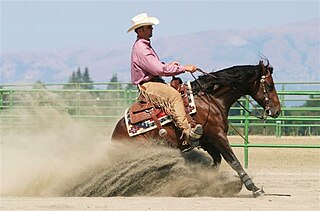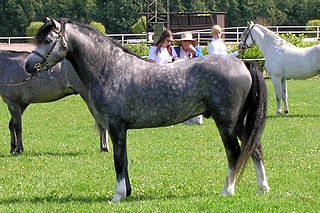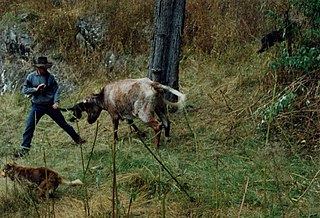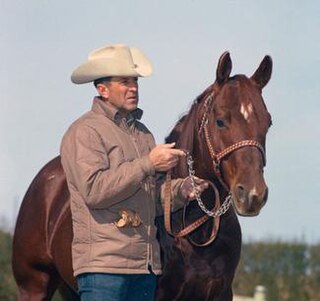
The American Quarter Horse, or Quarter Horse, is an American breed of horse that excels at sprinting short distances. Its name is derived from its ability to outrun other horse breeds in races of a quarter mile or less; some have been clocked at speeds up to 44 mph (70.8 km/h). The development of the Quarter Horse traces to the 1600s.

Equestrianism, commonly known as horse riding or horseback riding, includes the disciplines of riding, driving, and vaulting. This broad description includes the use of horses for practical working purposes, transportation, recreational activities, artistic or cultural exercises, and competitive sport.

Rodeo is a competitive equestrian sport that arose out of the working practices of cattle herding in Spain and Mexico, expanding throughout the Americas and to other nations. It was originally based on the skills required of the working vaqueros and later, cowboys, in what today is the western United States, western Canada, and northern Mexico. Today, it is a sporting event that involves horses and other livestock, designed to test the skill and speed of the cowboys and cowgirls. American-style professional rodeos generally comprise the following events: tie-down roping, team roping, steer wrestling, Steer roping, saddle bronc riding, bareback bronc riding, bull riding and barrel racing. The events are divided into two basic categories: the rough stock events and the timed events. Depending on sanctioning organization and region, other events such as breakaway roping, goat tying, and pole bending may also be a part of some rodeos. The "world's first public cowboy contest" was held on July 4, 1883, in Pecos, Texas, between cattle driver Trav Windham and roper Morg Livingston.

A cowboy is an animal herder who tends cattle on ranches in North America, traditionally on horseback, and often performs a multitude of other ranch-related tasks. The historic American cowboy of the late 19th century arose from the vaquero traditions of northern Mexico and became a figure of special significance and legend. A subtype, called a wrangler, specifically tends the horses used to work cattle. In addition to ranch work, some cowboys work for or participate in rodeos. Cowgirls, first defined as such in the late 19th century, had a less-well documented historical role, but in the modern world work at identical tasks and have obtained considerable respect for their achievements. Cattle handlers in many other parts of the world, particularly South America and stockmen and jackaroos in Australia, perform work similar to the cowboy.

A herder is a pastoral worker responsible for the care and management of a herd or flock of domestic animals, usually on open pasture. It is particularly associated with nomadic or transhumant management of stock, or with common land grazing. The work is often done either on foot or mounted.

A horse show is a judged exhibition of horses and ponies. Many different horse breeds and equestrian disciplines hold competitions worldwide, from local to the international levels. Most horse shows run from one to three days, sometimes longer for major, all-breed events or national and international championships in a given discipline or breed. Most shows consist of a series of different performances, called classes, wherein a group of horses with similar training or characteristics compete against one another for awards and, often, prize money.

Western saddles are used for western riding and are the saddles used on working horses on cattle ranches throughout the United States, particularly in the west. They are the "cowboy" saddles familiar to movie viewers, rodeo fans, and those who have gone on trail rides at guest ranches. This saddle was designed to provide security and comfort to the rider when spending long hours on a horse, traveling over rugged terrain.

Reining is a western riding competition for horses where the riders guide the horses through a precise pattern of circles, spins, and stops. All work is done at the lope, or the gallop. Originating from working cattle, reining is often described as a Western form of dressage riding, as it requires the horse to be responsive and in tune with its rider, whose aids should not be easily seen, and judges the horse on its ability to perform a set pattern of movements. The horse should be willingly guided or controlled with little or no apparent resistance and dictated to completely. A horse that pins his ears, conveying a threat to his rider, refuses to go forward, runs sideways, bounces his rear, wrings his tail in irritation or displays an overall poor attitude is not being guided willingly, and is judged accordingly.

The Welsh Pony and Cob is a group of four closely-related horse breeds including both pony and cob types, which originated in Wales in the United Kingdom. The four sections within the breed society for the Welsh breeds are primarily distinguished by height, and also by variations in type: the smallest Welsh Mountain Pony ; the slightly taller but refined Welsh Pony of riding type popular as a children's show mount; the small but stocky Welsh Pony of Cob Type, popular for riding and competitive driving; and the tallest, the Welsh Cob, which can be ridden by adults. Welsh ponies and cobs in all sections are known for their good temperament, hardiness, and free-moving gaits.

Western pleasure is a western style competition at horse shows that evaluates horses on manners and suitability of the horse for a relaxed and slow but collected gait cadence, along with calm and responsive disposition. The horse is to appear to be a "pleasure" to ride, smooth-moving and very comfortable. Most light horse breeds in the United States and Canada may compete in western pleasure classes, either in open competition or at shows limited to a single breed. However, horse conformation and temperament play a role in this event, and hence animals of stock horse breeds that are calm, quiet, have collected, soft gaits and the strong muscling required to sustain slow, controlled movement are the most competitive.

Cutting is a western-style equestrian competition in which a horse and rider work together before a judge or panel of judges to demonstrate the horse's athleticism and ability to handle cattle. Modern competition utilizes a 2+1⁄2 minute performance, called a "run." Each contestant is assisted by four helpers: two are designated as turnback riders, who help to keep cattle from running off to the back of the arena, the other two are designated as herd holders to keep the cattle bunched together and prevent potential strays from escaping into the work area. Cutting cattle are typically young steers and heifers that customarily range in size from 400 to 650 lb. They usually are of Angus or Hereford lineage though may be a mix of crossbred beef cattle, including Charolais or Brahman lineage.
The Florida Cracker Horse is a critically endangered horse breed from the state of Florida in the United States. It is genetically and physically similar to many other Spanish-style horses, especially those from the Spanish Colonial horse group, including the Banker horse of North Carolina, and the Carolina Marsh Tacky of South Carolina.

A muster (Au/NZ) or a roundup (US/Ca) is the process of gathering livestock. Musters usually involve cattle, sheep or horses, but may also include goats, camels, buffalo or other animals. Mustering may be conducted for a variety of reasons including routine livestock health checks and treatments, branding, shearing, lamb marking, sale, feeding and transport or droving to another location. Mustering is a long, difficult and sometimes dangerous job, especially on the vast Australian cattle stations of the Top End, 'The Falls' (gorge) country of the Great Dividing Range and the ranches of the western United States. The group of animals gathered in a muster is referred to as a "mob" in Australia and a "herd" in North America.

Western riding is considered a style of horse riding which has evolved from the ranching and welfare traditions which were brought to the Americas by the Spanish Conquistadors, as well as both equipment and riding style which evolved to meet the working needs of the cowboy in the American West. At the time, American cowboys had to work long hours in the saddle and often over rough terrain, sometimes having to rope a cattle using a lariat, also known as a lasso. Because of the necessity to control the horse with one hand and use a lariat with the other, western horses were trained to neck rein, that is, to change direction with light pressure of a rein against the horse's neck. Horses were also trained to exercise a certain degree of independence in using their natural instincts to follow the movements of a cow, thus a riding style developed that emphasized a deep, secure seat, and training methods encouraged a horse to be responsive on very light rein contact.

A cutting horse is a stock horse, typically an American Quarter Horse, bred and trained for cutting, a modern equestrian competition requiring a horse and rider to separate a single cow from a herd of cattle and prevent it from getting back to the herd. One of the desired qualities in a cutting horse is "cow sense," described as an innate ability to read a cow, eye to eye, in anticipation of each move. The cutting horse has its roots in the historic cattle ranching industry, where horses with specialized cattle-handling skills were crucial for the work of the cowboy.

Working cow horse or reined cow horse is a type of Western riding competition in which horse and rider are tested for ability to work cattle. It is organised by the National Reined Cow Horse Association in North America, and by the European Reined Cow Horse Association in Europe. Horses are judged on accuracy, timing, and responsiveness.

This is a basic glossary of equestrian terms that includes both technical terminology and jargon developed over the centuries for horses and other equidae, as well as various horse-related concepts. Where noted, some terms are used only in American English (US), only in British English (UK), or are regional to a particular part of the world, such as Australia (AU).

Matlock Rose, born Berry Matlock Rose (1924–2008), was a professional horse trainer for over 60 years. He established a reputation as an all-around cowboy and trainer of champions. Rose was often described as stonefaced, a man of few words, but long held the respect of his peers. He was referred to as a trainers' trainer, and considered a legend. He trained multiple AQHA world champions, five NCHA world champions, was inducted into the American Quarter Horse Hall of Fame in 2001, as well as both the NCHA Rider Hall of Fame and the NCHA Members Hall of Fame. The first famous cutting horse he trained was Jesse James and many other great horses followed but he was best known for training Peppy San and Peponita.



















